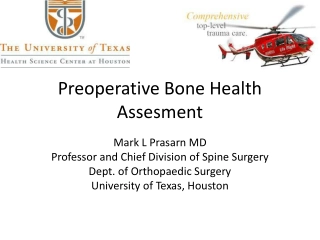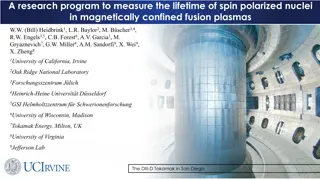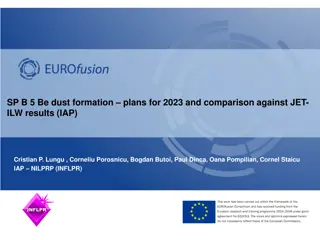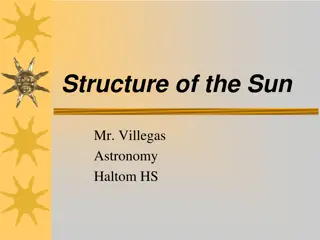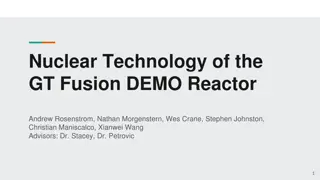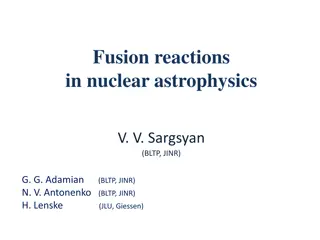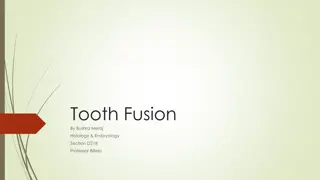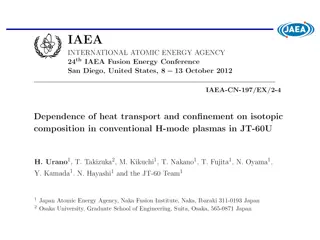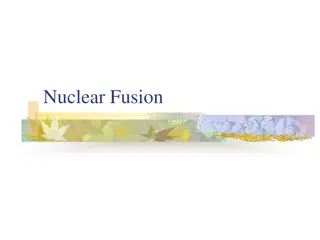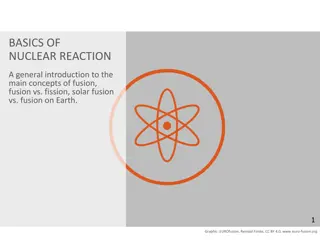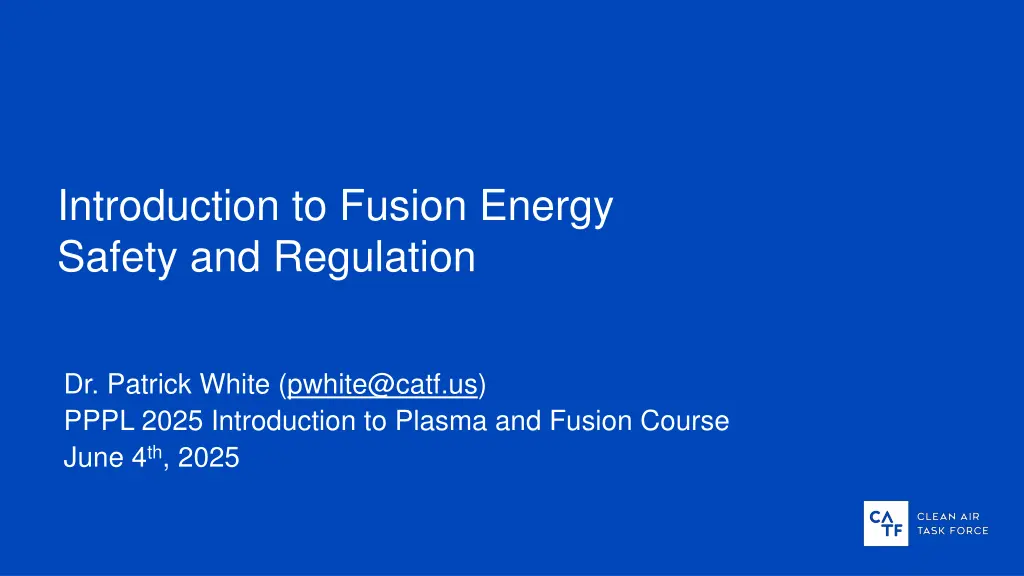
Fusion Energy Safety, Regulation, and Technologies Overview
Explore the landscape of commercial fusion energy with a focus on safety, regulation, and the diverse technologies in development. Learn about the Fusion Safety and Regulation Working Group's goal, the need for harmonized regulatory frameworks, and the various confinement methods shaping the future of fusion energy.
Download Presentation

Please find below an Image/Link to download the presentation.
The content on the website is provided AS IS for your information and personal use only. It may not be sold, licensed, or shared on other websites without obtaining consent from the author. If you encounter any issues during the download, it is possible that the publisher has removed the file from their server.
You are allowed to download the files provided on this website for personal or commercial use, subject to the condition that they are used lawfully. All files are the property of their respective owners.
The content on the website is provided AS IS for your information and personal use only. It may not be sold, licensed, or shared on other websites without obtaining consent from the author.
E N D
Presentation Transcript
Introduction to Fusion Energy Safety and Regulation Dr. Patrick White (pwhite@catf.us) PPPL 2025 Introduction to Plasma and Fusion Course June 4th, 2025
My personal background: thinking about hard questions at the intersection of technology and policy Technical Questions Policy Questions Stakeholder Communication 2
CATF Fusion Safety and Regulation Working Group Goal: Creating a harmonized framework for safety and regulation for commercial fusion energy that can be adopted internationally and enable the global deployment of fusion energy. This framework must include both public acceptance of fusion energy and commercial viability of the technology. Customers Investors Developers Regulatory Framework Public & NGOs Government Challenge: Varying regulatory needs throughout based on the specific fusion machine, technology lifecycle, and during different stages of commercialization. Regulators 3
Fusion energy has immense potential, but safety and regulation must be aligned to enable development Commercial Fusion Landscape Fusion Energy Regulation Other Fusion Considerations 4
The commercial fusion energy landscape has a wide range of different proposed concepts and technologies Commercial Fusion Landscape Fusion Energy Regulation Other Fusion Considerations 5
Fusion machines under development use different approaches for commercial energy generations Confinement Methods Fusion Reactions Fusion Fuel Cycles Power Conversion Cycle Facility Size 6
Fusion energy technologies are typically defined based on how they confine the plasma Magnetic Confinement Magneto Inertial Confinement Inertial Confinement Alternative Confinement Includes: Z-Pinch Field Reverse Configuration (FRC) Includes: Tokamak Stellerator Includes: Direct ICF Indirect ICF Includes: Electrostatic Muon Catalyzed 7
Different fusion fuels will have design and operational advantages and challenges 8
Fusion fuel cycles are needed to produce the specific isotopes required for fusion reactions Example: Deuterium-Tritium Fuel Production with Lithium-6 9
Fusion power conversion cycles may use traditional thermodynamic cycles or novel technologies Example: Direct Energy Conversion Example: Steam Rankine Cycle 10
Private companies are developing machines based on an array of different fusion energy technologies Confinement Methods Fusion Reactions Fusion Fuel Cycles Power Conversion Cycle Facility Size 11
Example: Commonwealth Fusion Systems ($2B+ Private Funding) Confinement Methods Magnetic Tokamak Fusion Reactions Fusion Fuel Cycles D-T Power Conversion FLiBe Blanket Breeding FLiBe Blanket to Rankine Cycle Facility Size 400 MWe 12
Example: Helion ($1B+ Private Funding) Confinement Methods Magneto Inertial Fusion Reactions Fusion Fuel Cycles D-3He D-D 3He Production, T Decay Power Conversion Direct Energy Conversion Facility Size 50 MWe 13
Example: Xcimer ($100M+ Private Funding) Confinement Methods Laser Inertial Confinement Fusion Reactions D-T Fusion Fuel Cycles Power Conversion FLiBe FLiBe Blanket to Rankine Cycle Facility Size 100 MWe 14
Development of commercial fusion energy will require multiple advances in fusion science and technology Scientific Demonstration Machines Engineering Demonstration Machines Commercial Demonstration Machines Commercial Machines At Scale Qscientific >> 1 Qengineering > 1 Cost competitive fusion energy Qscientific > 1 Qengineering >> 1 15
Regulation of commercial fusion energy will require efficient and effective licensing of many technologies Commercial Fusion Landscape Fusion Energy Regulation Other Fusion Considerations 16
Example: How to regulate every car and engine? Ford Model T 1908 Chevy Styleline 1950 DMC Delorean 1981 Otto Engine 1876 Wiztem Go Kart 2025 Honda Civic 2016 Shelby Supercars (SSC) Tuatara 2020 17
Challenges facing fusion machine deployment will evolve during fusion energy development and commercialization Scientific Demonstration Machines Engineering Demonstration Machines Commercial Demonstration Machines Commercial Machines At Scale Example: Regulatory needs for fusion will evolve over time based on machines purpose, hazards, experience, and industry maturity 18
Fusion reactions will have radiological hazards that need to be safely managed Activated Materials Tritium Neutron Fusion Machine Example Isotopes of Concern: 3H 14C 59Ni 63Ni 60Co 94Nb 93Mo 179Ta 182Ta 183Ta 184Re 186Re 187W 185W Helium Deuterium 19
Commercial deployment of fusion energy will requirement management of fusion hazards Example Radiological Hazards Example Industrial Hazards Neutron Activation Material Contamination Cryogenic Systems Magnetic Fields Direct Radiation Exposure Toxic Materials Stored Energy and Materials Tritium 20
Diversity of technical approaches and design maturity makes regulation of commercial fusion challenging Example: Regulating tritium hazards Potential fusion machine safety analyses could vary by factor of more than 10,000,000 based on machine-specific technology, design, and analysis choices! 10,000 gram EU DEMO? ITER? 1,000 gram Commercial Machine? 100 gram Hazard release conditions and exposure scenarios can change doses by more than a factor of 100,000 10 gram Test Machine? R&D Facility? 1 gram University Lab? 0.1 gram Total TritiumInventory 21
Fusion regulation in the United States is currently under development by NRC and agreement states 2020 2009 1980s 1990s DOE regulation PPPL TFTR Commission directs NRC staff to develop new options for licensing fusion energy NRC Commission asserts regulatory jurisdiction on fusion energy 2020 January 2023 NRC staff develop options paper for Commission on fusion licensing 1990s 2019 DOE development of ITER relevant safety guidance NEIMA defines fusion as advanced nuclear and directs rulemaking 22
NRC staff developed three different options for the near-term regulation of commercial fusion energy Recommended by Staff Regulate fusion energy systems under a hybrid framework based on potential hazards Regulate fusion energy systems under a byproduct material framework Regulate fusion energy systems under a utilization facility framework Option 1 10 CFR Part 50 Option 2 10 CFR Part 30 Option 3 10 CFR Part 30 for low hazards 10 CFR Part 50 for high hazards 23
Fusion regulation in the United States is currently under development by NRC and agreement states 2020 April 2023 2009 1980s 1990s DOE regulation PPPL TFTR Commission directs NRC staff to develop new options for licensing fusion energy Commission votes to license near-term fusion energy using 10 CFR Part 30 NRC Commission asserts regulatory jurisdiction on fusion energy 2020 January 2023 NRC staff develop options paper for Commission on fusion licensing 1990s 2019 DOE development of ITER relevant safety guidance NEIMA defines fusion as advanced nuclear and directs rulemaking 24
Commission voted to regulate fusion using the byproduct materials framework for near-term licensing Development of Guidance for Fusion Energy in NUREG-1556 Volume 22 Limited Scope Rulemaking on Fusion Energy Definitions Staff Implementation Actions Regulate fusion energy systems under a byproduct material framework Engagement with NRC Agreement States on Fusion Energy Regulation Option 2 10 CFR Part 30 25
Fusion regulation in the United States is currently under development by NRC and agreement states 2020 April 2023 2009 1980s 1990s DOE regulation PPPL TFTR Commission directs NRC staff to develop new options for licensing fusion energy Commission votes to license near-term fusion energy using 10 CFR Part 30 NRC Commission asserts regulatory jurisdiction on fusion energy 2020 January 2023 NRC staff develop options paper for Commission on fusion licensing 1990s 2019 December 2024 NRC staff submit proposed fusion energy regulation rule to Commission DOE development of ITER relevant safety guidance NEIMA defines fusion as advanced nuclear and directs rulemaking 26
Proportional, technology-inclusive, and performance-based regulation enable effective, scalable fusion licensing Applies to any proposed fusion machine Lowers barriers to fusion technology innovation Technology-Inclusive Requirements Utilizes quantifiable health and safety licensing criteria Enables demonstration of multiple approaches to fusion safety Performance-Based Requirements Scales reviews based on the specific level of hazards in application Ensures safety while reducing opportunities for over-regulation Proportional Licensing Requirements 27
Proportional licensing requirements enable regulations to scale based on the specific application Example: Regulating tritium hazards Documentation of Licensing Safety Case 10,000 gram EU DEMO? Licensing Analysis of Machine Safety ITER? 1,000 gram Commercial Machine? Engineered Safety Systems and Operational Safety Programs 100 gram 10 gram Test Machine? Off-site Emergency Planning and Response Requirements R&D Facility? 1 gram University Lab? Environmental Impact Review and Siting Requirements 0.1 gram Total TritiumInventory 28
Consensus on fusion regulatory principles and national implementation creates pathways for fusion deployment Technology-Inclusive Requirements Scientific Demonstration Machines Engineering Demonstration Machines Commercial Demonstration Machines Commercial Machines At Scale Performance-Based Requirements Certainty Predictability and Flexibility Scalability Proportional Licensing Requirements 29
Widescale deployment of fusion energy must also consider byproduct and non-proliferation questions Commercial Fusion Landscape Fusion Energy Regulation Other Fusion Considerations 30
Fusion machines will produce varying activated and contaminated materials based on design and operation Other Radioactive Contaminated Materials Activated Structural Materials Tritiated Contaminated Materials Radioactive material production will depend on fusion neutron energy, flux, and fluence; material selection and material impurities; operational time 31
Successful deployment of fusion energy should include management of byproducts from a commercial lifecycle Sustainable FPPs by Design FPP Lifecycle Characterization FPP Waste Characterization Sustainability Strategies for FPP FPP Lifecycle Management Storage Reduce On-site or In-situ Storage Consolidated Storage Reduce by Design and Operation Reduce Waste Quantity/Volume FPP Construction On-going Wastes Reduce by Post-Processing Reduce Waste Hazards Transportation FPP Operation Existing Infrastructure New FPP Design Process Periodic Wastes Reuse Infrastructure FPP Direct Material Reuse Material Refurbishment Maintenance Disposal One-time Wastes Hazardous Waste Disposal Effluent Release FPP Recycle Decomm. Recycle for FPP Use Recycle for Industrial Use Industrial Waste Disposal Radiological Waste Disposal Waste Quantity and Volume Waste Physical Characteristics Waste Hazards (Rad., Chem., Bio.) 32
Evaluation of existing export controls and systems is needed to assess impact of fusion energy on proliferation Sensitive dual-use materials High energy and high fluence neutron source Sensitive dual-use technology Sensitive dual-use knowledge Production of special nuclear material Tritium, Lithium isotope separation, high energy and high fluence neutron generators Inertial confinement fusion data enriched lithium 33
Fusion energy has immense potential, but safety and regulation can be aligned to enable deployment Commercial Fusion Landscape Fusion Energy Regulation Other Fusion Considerations 34


